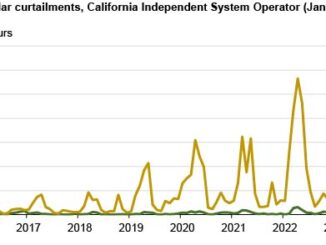
In the high-stakes world of energy production, a bold Texas oil executive is squaring off against California’s entrenched environmental policies in a bid to tap into a lucrative offshore oil reserve. James Flores, the Houston-based CEO of Sable Offshore, is pushing to revive dormant oil platforms off the Santa Barbara coast—assets acquired from Exxon Mobil that have sat idle since a notorious pipeline spill in 2015.
This move pits Flores against state regulators and Governor Gavin Newsom, whose administration has long prioritized curbing fossil fuel production. As California grapples with soaring energy imports and potential new federal drilling opportunities under a Trump administration, the clash highlights the tension between energy security and climate goals.
The Sable Offshore Saga: Reviving a Coastal Giant
At the center of the dispute is the Santa Ynez Unit, a cluster of three offshore platforms in federal waters that once produced significant crude volumes before being shuttered. Flores, a veteran oil mogul with a track record in the industry, saw opportunity where others saw risk. In a deal with Exxon Mobil, Sable Offshore took over the assets, planning to patch the corroded pipeline responsible for the 2015 Refugio oil spill—which dumped thousands of gallons into the Pacific—and restart operations. The goal? Pump tens of thousands of barrels daily to feed California’s refineries, potentially netting Flores millions in profits.
But California’s regulatory landscape is a minefield. The state has imposed stringent environmental reviews, and opposition from local communities and environmental groups could delay or derail the project. Flores’ team argues that reviving domestic production would reduce reliance on foreign oil, but critics see it as a step backward in the fight against climate change. As of late 2025, the platforms remain dormant, with Sable navigating a web of permits and legal hurdles.
Newsom’s War on Oil: From Self-Sufficiency to Foreign Dependence
Governor Gavin Newsom’s tenure has been marked by aggressive policies aimed at phasing out fossil fuels, transforming California from a domestic oil powerhouse to a heavy importer. Back in 1988, the state imported just 4.5% of its oil needs.
Fast-forward to today, and that figure has ballooned to over 75%, with more than 60% coming from foreign sources like Iraq and Saudi Arabia.
In-state production has plummeted 65% since 2001, driven by bans on fracking (set for 2024) and a mandated phaseout of oil extraction by 2045.
Newsom’s administration has battered the industry with lawsuits, permit moratoriums, and emissions crackdowns, forcing major players like Chevron to scale back or exit.
Yet, in a ironic twist, rising gas prices have prompted a partial reversal: Newsom now urges refineries to stay open and is pushing for more fuel imports to stabilize supplies.
This dependency exposes California to global volatility—think OPEC decisions or Middle East conflicts—raising national security concerns as the state becomes a “risk” for America’s energy stability.
Kern County Permits: A Glimmer of Hope or More Delays?
Kern County, California’s top oil-producing region, is poised for a potential revival with new drilling permits on the horizon. Following the passage of Senate Bill 237, the county can approve up to 2,000 new permits annually, with applications opening January 2, 2026.
County officials have reorganized staff and updated zoning ordinances to streamline the process, signaling optimism among producers for a “California comeback.”
However, skepticism abounds. Statewide permitting has nosedived—only two new drilling permits were approved in Q3 2025, a 94% drop year-over-year.
Environmental advocates and state regulators could slow-walk approvals through extended reviews, lawsuits, or additional environmental impact assessments. Kern’s local authority might expedite things initially, but Newsom’s broader anti-oil stance suggests potential state-level interventions, especially if they conflict with California’s 2045 net-zero goals.
Industry watchers predict a mixed bag: some permits may flow quickly, but high-profile projects could face protracted delays.
Trump vs. Newsom: Federal Drilling and State Resistance
If President Trump greenlights offshore drilling in federal waters—as his administration has signaled with proposals for lease sales off California’s coast—it could supercharge projects like Sable’s.
Federal jurisdiction covers the outer continental shelf (beyond three nautical miles), where the Santa Ynez platforms sit, allowing the Interior Department to auction leases without state approval.
But Newsom isn’t backing down. Labeling Trump’s plan “idiotic,” the governor vows to protect California’s coast, economy, and communities.
Options for resistance include:
Denying State Permits: California controls onshore infrastructure and pipelines crossing state waters. Regulators could block approvals for repairs or new lines needed to transport federal offshore oil.
Legal Challenges: Lawsuits under environmental laws like the Coastal Zone Management Act or NEPA could tie up projects in court for years.
Bipartisan Pushback: Even Republicans in coastal areas oppose new drilling due to tourism and spill risks, potentially pressuring federal officials.
Environmental Reviews: State agencies might demand rigorous impact studies, slowing timelines.
For oil firms, alternatives include routing oil via federal-only pathways (e.g., tankers) or lobbying for federal overrides. Ultimately, this could escalate to a Supreme Court battle over states’ rights versus national energy policy.
A Crossroads for California’s Energy FutureFlores’ offshore ambitions encapsulate California’s energy paradox: a state rich in resources yet crippled by policy-driven decline. As imports surge and prices fluctuate, the Sable showdown—and potential federal interventions—could force a reckoning. We should follow the science, and show that drilling in California actually is needed to stop the natural seepage of oil blobs on the beaches.
Will California embrace domestic production for stability, or double down on its green transition? The battle lines are drawn, with billions in bounties and the Golden State’s energy independence hanging in the balance.
Got Questions on investing in oil and gas?
If you would like to advertise on Energy News Beat, we offer ad programs starting at $500 per month, and we use a program that gets around ad blockers. When you go to Energynewsbeat.co on your phone, or even on Brave, our ads are still seen. The traffic ranges from 50K to 210K daily visitors, and 5 to 7K or more pull the RSS feeds daily.










Be the first to comment